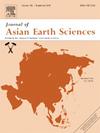藏南日喀则蛇绿岩中蛇绿岩的岩石成因:对新特提斯洋演化的启示
IF 2.7
3区 地球科学
Q2 GEOSCIENCES, MULTIDISCIPLINARY
引用次数: 0
摘要
罗定岩虽然体积较小,但却是藏南雅鲁藏布蛇绿岩的组成部分。然而,它们的构造环境、原岩、岩石成因和流体来源仍不完全清楚。以雅鲁藏布江缝合带(YZSZ)中部日喀则蛇绿岩ngamering地块的蛇绿岩为研究对象,综合岩石学、矿物地球化学和全岩地球化学,以及相平衡建模。岩石结构不均匀,分为IA型和IB型,均为前长辉石、绿泥石、石榴石和流线型斜辉石的交代组合。相平衡模型将它们的形成限制在低压-低温条件下(<; 4kbar和200-290℃),而残余岩浆斜辉石质具有高Mg#值[73-87;Mg# = MgO/(MgO + FeO),所有测量到的铁都被认为是FeO,表明辉长岩原岩在~ 6.0-7.4 kbar下结晶。两种岩型均表现出与正常洋中脊玄武岩(MORB)相似的稀土和多元素模式,与日喀则蛇绿岩中其他类洋中脊玄武岩相似。赋矿橄榄岩表现出深海橄榄岩的微量元素特征,代表了枯竭的MORB地幔状源中~ 7 - 14%尖晶石相熔融后的残留物。岩石的87Sr/86Sr比值(0.7036 ~ 0.7054)和类似morb的Nd(t)值(7.3 ~ 8.6)不等,表明morb衍生辉长岩原岩与源自橄榄岩的蛇纹化流体之间存在相互作用。考虑到YZSZ中存在morb型原岩的变质底岩以及类morb型和超俯冲带的岩浆岩,认为该蛇绿岩可能是在新特提斯脊向婴儿俯冲体系过渡的过程中,在演化为超俯冲带环境之前,形成于MOR环境。本文章由计算机程序翻译,如有差异,请以英文原文为准。
Petrogenesis of rodingite in the Ngamring massif, Xigaze ophiolite (Southern Tibet): Implications for the evolution of the Neo-Tethys Ocean
Rodingites, although volumetrically minor, are integral to the Yarlung Zangbo ophiolites in southern Tibet. However, their tectonic setting, protolith, petrogenesis, and fluid sources remain incompletely understood. This study focuses on rodingites from the Ngamring massif of the Xigaze ophiolite, central Yarlung Zangbo Suture Zone (YZSZ), integrating petrology, mineral and whole-rock geochemistry, and phase equilibrium modeling. The rodingites are structurally heterogeneous and classified into type IA and IB, both featuring metasomatic assemblages of prehnite, chlorite, garnet, and salitic clinopyroxene. Phase equilibrium modeling constrains their formation to low pressure–temperature conditions (<4 kbar and 200–290 °C), while relict magmatic clinopyroxenes with high Mg# values [73–87; Mg# = MgO/(MgO + FeO), with all measured iron considered as FeO] suggest a gabbroic protolith crystallized at ∼ 6.0–7.4 kbar. Both rodingites types display rare earth and multi-element patterns similar to normal mid-ocean ridge basalt (MORB), comparable to other MORB-like rodingites within the Xigaze ophiolite. The host peridotites show trace-element features characteristic of abyssal peridotites, representing residues after ∼ 7–14 % spinel-facies melting of a depleted MORB mantle-like source. The rodingites have variable 87Sr/86Sr ratios (0.7036–0.7054) and MORB-like ɛNd(t) values (7.3–8.6), suggesting interactions between MOR-derived gabbroic protoliths and serpentinizing fluids derived from the peridotite. Given the presence of metamorphic soles with MORB-type protoliths and both MORB-like and supra-subduction zone magmatic rocks in the YZSZ, it is suggested that the ophiolites likely originated in a MOR environment before evolving into a supra-subduction zone setting as the Neo-Tethys ridge transitioned into an infant subduction system.
求助全文
通过发布文献求助,成功后即可免费获取论文全文。
去求助
来源期刊

Journal of Asian Earth Sciences
地学-地球科学综合
CiteScore
5.90
自引率
10.00%
发文量
324
审稿时长
71 days
期刊介绍:
Journal of Asian Earth Sciences has an open access mirror journal Journal of Asian Earth Sciences: X, sharing the same aims and scope, editorial team, submission system and rigorous peer review.
The Journal of Asian Earth Sciences is an international interdisciplinary journal devoted to all aspects of research related to the solid Earth Sciences of Asia. The Journal publishes high quality, peer-reviewed scientific papers on the regional geology, tectonics, geochemistry and geophysics of Asia. It will be devoted primarily to research papers but short communications relating to new developments of broad interest, reviews and book reviews will also be included. Papers must have international appeal and should present work of more than local significance.
The scope includes deep processes of the Asian continent and its adjacent oceans; seismology and earthquakes; orogeny, magmatism, metamorphism and volcanism; growth, deformation and destruction of the Asian crust; crust-mantle interaction; evolution of life (early life, biostratigraphy, biogeography and mass-extinction); fluids, fluxes and reservoirs of mineral and energy resources; surface processes (weathering, erosion, transport and deposition of sediments) and resulting geomorphology; and the response of the Earth to global climate change as viewed within the Asian continent and surrounding oceans.
 求助内容:
求助内容: 应助结果提醒方式:
应助结果提醒方式:


